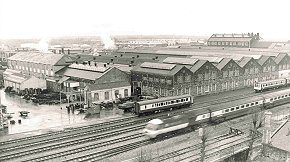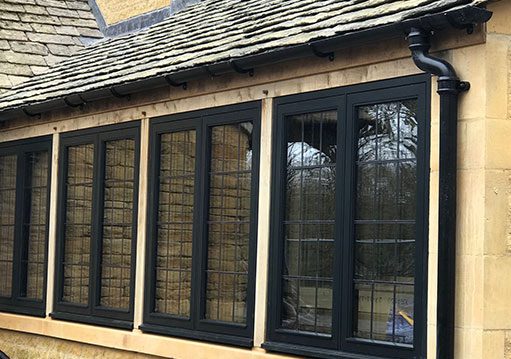The History and Heritage of Cast Iron in Swindon
Swindon Designer Outlet is a covered designer outlet in Swindon, Wiltshire, England. The outlet occupies the restored Great Western railway works and is owned by McArthur Glen.
The dictionary definition of Heritage is: features belonging to the culture of a particular society, such as traditions, languages, or buildings, that were created in the past and still have historical importance.
“unlike all (I think, but don’t quote me) the other McArthur Glen outlet villages in the UK, the Swindon one is not purpose built. As pleasant as they all undoubtedly are, I love that the Swindon one has taken the home of a once glorious, but now long-gone industry… the workshops of the Great Western Railway… the character of the workshops has been retained”1
The Great Western Railway (GWR) was engineered by Isambard Kingdom Brunel. Many of the company’s locomotives were built in the company’s workshops at Swindon.2
SWINDON — the town on the hill — dates back at least eight centuries and is mentioned in the Domesday Book. It was an ancient market town of some note when the Great Western Railway came into being.2
With the rapid growth of the railway arose the necessity for the provision of a central repair depot for the maintenance of the locomotive Stock.2
In 1840 Mr Daniel Gooch, Brunel’s Locomotive Superintendent who had been trained with Robert Stephenson and Co said
“I was called upon to report on the best situation to build these works, and on full consideration I reported in favour of Swindon, it being the junction with the Cheltenham branch and also a convenient division of the Great Western line for the engine working. Mr. Brunel and I went to look at the ground, then only green fields, and he agreed with me as to its being the best place.” 2
Similar considerations made the location of Rainclear in Swindon ideal, on the M4 corridor with swift access to the motorway network throughout mainland UK.
The company Directors authorised the construction of such a depot at Swindon on February 25th, 1841.2
With the absorption of the West Midland Group into GWR in 1861, the Directors of the Great Western Railway decided that central works for the construction of carriages and wagons (i.e. not just repairs) were desirable. Swindon was chosen for the Carriage and Wagon Works, and these were authorised by the Directors in October, 1867.2
The Swindon Works of the Great Western Railway comprised one of the largest railway establishments for the construction and repair of locomotives, carriages, and wagons in the world.2
The Works are divided into three sections, Locomotive, Carriage, and Wagon, and together they cover an area of 323 acres, of which 73 are roofed. The machinery was driven electrically, the power being obtained from the Swindon Corporation Power Station. The Great Western Railway Company’s maximum demand being approximately 45 per cent of the total demand on the power station.2
WORKSHOP ‘J‘- IRON FOUNDRY
On the charging floor of the ‘cupolas’ (vertical brick-lined furnaces) is the charging mouthpiece through which are passed, in specific proportions, pig iron, scrap iron, and coke.2
The blowers producing the blast are electrically driven and capable of forcing 9,000 cubic feet of air per minute against a pressure of 16 inches water gauge.2
The molten metal issues from each cupola at the rate of 5 to 12 tons per hour as required. The total output of finished castings is about 9,000 to 10,000 tons per annum.2
One of the most interesting of the castings is that for the combined cylinder and saddle for a “King” class locomotive. For its production it is necessary to make the moulding boxes in four separate parts, with twenty separate cores.2
The largest casting produced in this foundry was one of 65 tons for the anvil block of a 4-ton drop stamp.2
Out of the total of 12,000 persons normally employed in Swindon Works in 1935, about 7,000 were engaged in The Locomotive Works which included Fitting, Erecting, Boiler-making and Machine Shops; Iron and Brass Foundries; Smiths’, Tinsmiths’ and Coppersmiths’ Shops, Rolling Mills, etc.
Over 1,000 locomotives were repaired here annually, whilst the capacity for constructing new engines was approximately two per week.2
The railway dominated the fortunes of Swindon until after the Second World War, when new industries moved to the area. The completion of the last steam locomotive for British Railways – Evening Star – at Swindon in 1960, marked a watershed in the history of the works, and in 1963 a large part of the old carriage and wagon works on the eastern side of the Gloucester branch line was closed and sold for redevelopment.3


The purchase of the works site in 1986 by Tarmac Properties offered the opportunity to redevelop a large part of Swindon that was largely unknown to its population. Surrounded by high walls for most of its history, few Swindonians – apart from those who worked there – had much opportunity to view the heritage which had played such an important part in the development of their town. What also became apparent was the significance of the architectural heritage, which had survived the 150-year occupation of the site by the GWR and its successors.3
Cast Iron is a material that has stood the test of time and our architectural heritage has much to thank those skillful engineers and foundrymen of yester-year. The use of cast iron in buildings has diminished greatly since the age of the industrial revolution and the Victorians, with modern materials offering faster construction solutions, however, there are still a small number of products that remain relevant even today. Cast iron guttering is one of them. Manufacturers such as Alumasc and Hargreaves continue the tradition of manufacturing cast iron rainwater goods and they are made using traditional foundry methods.
Rainclear, in the tradition of the old GWR and in recognition of the heritage of its home town, Swindon, proudly promotes the continued use of traditionally produced Cast Iron in the form of rainwater goods – Gutters, Hoppers and Downpipes – in the building and restoration of heritage properties throughout the UK.

Footnotes:
- Accessed 06/07/18: http://swindonian.me/2013/10/22/swindon-designer-outlet-village/
- Accessed 06/07/18: https://www.gracesguide.co.uk/Swindon_Works_in_1935
- Accessed 06/07/18: https://www.steam-museum.org.uk/aboutus/Pages/HistoryofSTEAM.aspx
Image credits:
- Photo of McArthur Glen’s Swindon Designer Outlet from https://threalestate.com/properties-and-developments/swindon-designer-outlet accessed 06/07/18
- Photo of McArthur Glen’s Swindon Designer Outlet from http://all-outlets.com/outlets/united-kingdom/swindon-designer-outlet accessed 06/07/18
- Photo of The Iron Foundry from https://www.gracesguide.co.uk/Swindon_Works_in_1935 accessed 06/07/18
- Railway Works Site photo 1 from https://www.steam-museum.org.uk/aboutus/Pages/HistoryofSTEAM.aspx accessed 06/07/18
- Railway Works Site photo 2 from https://www.steam-museum.org.uk/aboutus/Pages/HistoryofSTEAM.aspx accessed 06/07/18
- J Shop – Iron Foundry, 1951 Casting cylinders photo from https://www.steampicturelibrary.com/places/swindon-works-gwr-locomotive-works-j-shop/j-shop-iron-foundry-1951-459425.html?fst=13 accessed 06/07/18
- HGC Building Ltd install of Cast Iron in Cotswolds – shared with us by installer 23/03/18
- Bespoke Cast Iron Rainwater goods still cast to order today http://www.hargreavesfoundry.co.uk/cast_iron_drainage/premier_rainwater_soil/premiercast_case_studies/casestudyview/28 accessed 06/07/18

